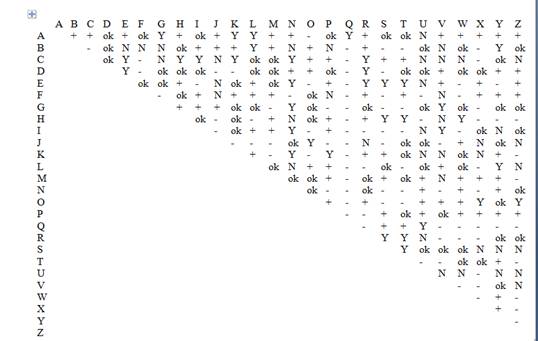One of the most important and yet confusing concepts is synergy. While some synergies can be easily figured out by observation (QU or CH for instance), others may not be as obvious (such as RT or CE).
Formally, the definition of synergy is the following: We can call a leave synergic if V{E(1)} + . . . V{E(k)} < V{E1, . . . Ek} (if the sum of the value of each tile is less than the worth of the leave as a whole)
While many tile combinations possess synergies, most of these synergies are insignificant. Even significant tile synergies do not require you to sacrifice a lot of points. For example, with an opening rack like CCHHLNU, you’re better off playing HUNCH than LUNCH despite the CH synergy. Synergies are usually a minor detail and are less important than vowel-consonant ratio or tile equity.
Nevertheless, it can still be a useful detail, especially when there are two plays that score a similar amount of points. Although small mistakes don’t mean a lot individually, many of these synergy decisions occur all the time: thus, small mistakes can really add up.
Here are some guidelines you can use to figure out which tiles are synergic:
1. Bingo tiles are generally synergic with other bingo tiles. (exceptions include LN, LR, and to a smaller degree RN)
2. Poor tiles that form a word are usually synergic. Letters like STXY (XYST) and GPPUY (GUPPY) are better than their ugly components because you can often get rid of many or all of your tiles next turn. Likewise, prefixes and suffixes have a synergy, depending upon their commonness. Strong synergies include OVER and ABLE, while weak synergies include OUT and SUB.
3. Three and four point tiles that form short words with each other or with XJZ have small synergies, such as JAB, ZAX, FOB, etc. This is true because sometimes there are places on the board to play these words and score well.
4. Scoring vowels are synergic with scoring consonants. Thus, combinations such as JO or ZA are synergic. Likewise, Bingo tiles are synergic with other bingo tiles. Leaves like RENT are worth a lot more than the R, E, N and T are worth individually, and thus a leave like ERT is much better than ERX.
On the converse, here are some rules for determining anti-synergic combinations:
1. Clunkers do not get along with each other unless they form short words. (V goes horribly with almost any other junk tile, JC has a significant synergy, GK, etc.)
2. Letters that have strong synergies also have strong antisynergies. For example, since the H has a lot of strong positive synergies (CH, PH, WH, TH, SH), it also has a lot of antisynergies (such as HN, HL, etc.)
3. Consonants that are “hard” are antisynergic with other hard consonants, while consonants that are “soft” are antisynergic with other soft consonants.
Soft consonants include: S, L, R, N
Hard consonants include: D, T, clunkers.
Tiles in the middle include the M and Y.
Note that these are not hard and fast rules. Other anti-synergies include ENOT, ACDET, AELN, and ENPT.
Synergy Table:
Add synergies in the synergy table. For example, BL is synergic, so (-4 + -0.5 < BL). With most synergies, add about 2 points on average: some are more significant, and some are less significant. Therefore, BL is worth about -2.5: (2 – 4 – 0.5).

Key:
Y: synergy greater than 1 point
+: synergy between 0.5 and 1 points
ok: synergy between -0.5 and 0.5 points
-: synergy between -1 and -0.5 points
N: synergy less than -1 point
